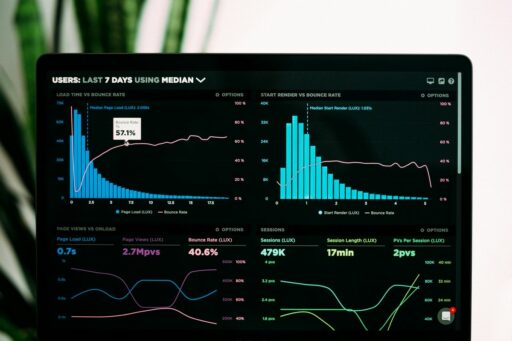Table of Contents
The field of data analysis is rapidly evolving, with salaries reflecting the growing importance of data-driven decision-making across industries. Understanding the salary landscape is crucial for both current and aspiring data analysts. This article delves into the various factors influencing data analyst salaries, the growth trajectory of these earnings, and how to maximize earning potential within this dynamic career path.
Key Takeaways
- Data analysts command high salaries due to strong demand, with rapid salary growth over the past decade and higher pay for those with specialized skills or experience.
- The median total pay for a Data Analyst in the United States is approximately $82,262 per year, with a base salary of $76,975 and potential additional earnings of $5,287.
- Salary progression for data analysts is influenced by experience, certifications, advanced degrees, and transitioning to higher roles such as data scientists.
- Current trends show a positive salary trajectory, with variations depending on industry, company size, and geographic location.
- Data analysts can increase their earning potential through continuous learning, skill development, and strategic career advancements.
Understanding the Salary Landscape for Data Analysts

Factors Influencing Data Analyst Salaries
The compensation for data analysts can vary widely, influenced by a myriad of factors. The primary determinants include experience, education, industry, and location. For instance, entry-level positions typically offer lower salaries compared to roles requiring several years of experience.
Education also plays a crucial role, with higher degrees often commanding better pay. However, the industry can dictate the upper limits of salary potential, with tech and finance sectors usually at the forefront. Geographic location impacts salaries due to cost of living differences and regional demand for data expertise.
The estimated total pay for a Data Analyst in the United States is $82,262 per year, with an average base salary of $76,975. Additional compensation such as bonuses and profit sharing can add an average of $5,287 per year.
Here’s a quick glance at how experience levels correlate with salary ranges:
| Experience Level | Salary Range (USD) |
|---|---|
| 0-1 Years | $110,500 – $126,000 |
| 1-3 Years | $126,000 – $138,500 |
| 4-6 Years | Data Not Available |
| 7-9 Years | Data Not Available |
| 10-14 Years | Data Not Available |
| 15+ Years | Data Not Available |
While these figures provide a snapshot, it’s important to note that actual salaries can differ based on specific job roles, company sizes, and other unique factors.
The Role of Experience and Education
The trajectory of a data analyst’s career is significantly influenced by their experience and educational background. Entry-level analysts typically focus on data cleaning and preliminary analysis, while those with more experience are expected to handle complex data sets and provide strategic insights. As analysts progress in their careers, they often take on roles that involve developing and maintaining dashboards, collaborating with cross-functional teams, and presenting findings to stakeholders.
Education also plays a pivotal role in shaping a data analyst’s career. A strong foundation in data analysis, statistics, or computer science is essential. For those looking to further specialize or aim for higher-paying roles, pursuing advanced degrees or professional certifications can be a game-changer.
Here’s a brief overview of how experience and education can impact salaries:
- Entry-Level: Focus on data cleaning, preliminary analysis.
- Mid-Level: Independent complex analysis, dashboard development, cross-functional collaboration.
- Senior-Level: Strategic insight provision, senior management collaboration, mentoring juniors.
Continued education and certification are key to advancing in this dynamic field. Certifications such as the Certified Analytics Professional or Cloudera Certified Associate Data Analyst can significantly enhance a professional’s credibility and salary prospects.
Industry Variations and Geographic Differences
The salary of a data analyst can significantly vary depending on the industry and location. Industries such as Information Technology and Financial Services typically offer higher salaries compared to other sectors. For instance, data analysts in the Information Technology sector can expect to earn about 12% more than their peers in other industries.
| Industry | Total Pay | Insight |
|---|---|---|
| Information Technology | $93,041 | 12% Higher than other industries |
| Financial Services | $92,410 | 12% Higher than other industries |
| Energy, Mining & Utilities | $85,673 | 5% Higher than other industries |
| Pharmaceutical & Biotechnology | $83,454 | 2% Higher than other industries |
| Insurance | $83,377 | 2% Higher than other industries |
Geographic location also plays a crucial role in determining salaries. Data analysts in major metropolitan areas or regions with a high cost of living often command higher wages. > The highest salary for a data analyst in the US stands at USD 86,000, reflecting the premium paid for expertise in certain locations and industries.
The Growth Trajectory of Data Analyst Salaries

Entry-Level to Senior-Level Salary Progression
The journey from entry-level to senior-level positions for data analysts is marked by a steady increase in salary, reflecting the accumulation of experience and expertise. Entry-level data analysts typically start by honing their skills in data cleaning and basic analysis. With time, they take on more complex tasks and may see their salaries grow as they become proficient in advanced statistical methods.
As data analysts climb the career ladder, their roles evolve. Mid-level analysts often handle larger projects and may specialize in certain types of data or industries. The transition to a senior data analyst involves leading analytics projects, mentoring junior analysts, and a significant salary bump. For those aiming higher, positions such as Analytics Manager or even Data Scientist become attainable, each with its own salary scale.
| Experience Level | 25th Percentile | 50th Percentile | 75th Percentile |
|---|---|---|---|
| Entry-Level | $60,000 | $70,000 | $80,000 |
| Mid-Level | $85,000 | $95,000 | $110,000 |
| Senior-Level | $115,000 | $135,000 | $150,000 |
The salary progression for data analysts is not just a function of time but also of the value they bring to an organization. As analysts develop a deeper understanding of data and its implications for business strategy, their compensation reflects their growing impact.
It’s important to note that while data analysts interpret existing data, data scientists focus on designing data processing systems and developing new methods for data analysis. Both roles require specific skills and experience in math, programming, and business acumen, which can influence salary trajectories.
The Impact of Certifications and Advanced Degrees
In the competitive field of data analysis, certifications and advanced degrees can be a significant differentiator. Earning a specialized certification or an advanced degree often correlates with higher salaries and improved job prospects. For instance, a master’s degree in data analysis, statistics, computer science, or a related field can be a substantial asset.
Professional certifications are equally influential. They not only enhance credibility but also open doors to higher-paying roles. Certifications such as the Certified Analytics Professional, Cloudera Certified Associate Data Analyst, and various cloud certifications, particularly in AWS and Microsoft Azure, have been linked to salary increases.
The pursuit of further education and certifications is not just about a salary boost—it’s an investment in one’s career longevity and relevance in an ever-evolving industry.
Here’s a snapshot of how certifications can impact salary potential:
| Certification | Expected Salary Increase |
|---|---|
| AWS Certified | 10-20% |
| Azure Certified | 10-15% |
| Certified Analytics Professional | 5-10% |
Continual learning and professional development are essential in the dynamic field of data analytics. Staying abreast of the latest trends and technologies through certifications and advanced education can lead to more lucrative and fulfilling career opportunities.
Comparing Data Analyst and Data Scientist Salary Potentials
When it comes to salary, data analysts and data scientists often see different scales of compensation due to the complexity and demand of their respective roles. Data scientists typically command higher salaries than data analysts, reflecting the advanced analytical skills and technical expertise required in their positions. However, the gap between these roles can vary based on industry, experience, and geographic location.
| Role | Median Salary | 25th Percentile | 75th Percentile |
|---|---|---|---|
| Data Analyst | $76,975 | $110,500 | $138,500 |
| Data Scientist | $95,000 | $120,000 | $165,000 |
Note: The above figures are based on median salaries in the United States and are subject to change with market conditions.
The progression from data analyst to data scientist is a natural career trajectory for many professionals in the field. With the right mix of experience, education, and skill development, data analysts can transition into the more lucrative data scientist role, leveraging their expertise for higher paying opportunities.
Additional Compensation Considerations

Understanding Total Pay Beyond Base Salary
When considering a career as a data analyst, it’s crucial to look beyond the base salary to understand the total compensation package. Total pay includes not only the base salary but also additional forms of compensation such as bonuses, commissions, and benefits, which can significantly increase the overall earnings.
For instance, a typical total pay range for a data analyst might span from $66,000 to $103,000 per year, with base pay constituting $62,000 to $96,000 of that amount and additional pay ranging from $4,000 to $7,000 annually. This additional pay can come in various forms:
- Bonuses for meeting or exceeding performance targets
- Commissions from sales or revenue generated
- Profit sharing from the company’s earnings
- Stock options or equity in the company
It’s important to recognize that these components of total pay can vary widely depending on the company, industry, and geographic location. For example, data analysts in the information technology sector may receive a total pay that is 12% higher than other industries.
Understanding the nuances of total pay is essential for data analysts to accurately assess job offers and negotiate salaries that reflect their true value to an organization.
The Significance of Bonuses, Commissions, and Profit Sharing
In the realm of data analyst compensation, base salary is often just the starting point. Bonuses, commissions, and profit sharing play a pivotal role in the overall earnings of these professionals. These forms of variable pay can significantly boost an individual’s income, reflecting their performance, the company’s success, or both.
Variable pay, such as bonuses and profit sharing, is not just an extra perk; it’s a strategic tool for companies to incentivize and retain top talent.
While bonuses are typically tied to individual or team performance metrics, profit sharing connects employees to the broader success of the company, fostering a sense of ownership and alignment with business goals. Commissions, though less common in data analyst roles, can be a factor in sales-oriented industries or positions with a strong business development component.
Here’s a simplified breakdown of how these additional compensation forms might look for a data analyst:
| Compensation Type | Description | Potential Impact on Total Pay |
|---|---|---|
| Bonus | Often based on performance and company profitability | Can add a significant percentage to base salary |
| Commission | Usually tied to sales or revenue targets | Varies widely, may not apply to all analyst roles |
| Profit Sharing | Allocated based on company’s profits | Encourages long-term commitment and can be substantial |
Understanding the structure and potential of these additional earnings is crucial for data analysts navigating their career paths and for employers aiming to attract skilled talent.
Negotiating Your Salary Package
Entering salary negotiations can be daunting, but for data analysts, it’s a vital part of the process. Begin by researching the typical earnings for your role in your area, considering factors like experience, education, and industry. For instance, sectors like investment banking may offer more leverage than retail. Armed with this knowledge, propose a salary that’s about 20% above your current compensation or the initial offer. This sets a strong starting point for discussions.
When discussing your salary, remember to factor in the entire compensation package. This includes base salary, bonuses, and any additional benefits. Use tools like a Cost of Living Calculator or a Career Path Planner to inform your negotiations. Here’s a simple table to help you prepare:
| Tool | Purpose |
|---|---|
| Cost of Living Calculator | Compare expenses across states |
| Career Path Planner | Explore potential career trajectories |
| College ROI | Assess college investment returns |
Negotiating effectively requires a clear understanding of your market value and the confidence to request what you deserve. Keep in mind that your skills in problem-solving with data are highly valued and contribute significantly to business growth.
Current Trends in Data Analyst Salaries

Recent Salary Trends and Predictions
The salary landscape for data analysts has been subject to dynamic changes, reflecting the evolving nature of the industry. Recent estimates suggest that data analysts make about $82,000 per year, with variations depending on factors such as experience, location, and industry. This figure aligns with data from late December 2023, indicating a steady climb in compensation for these professionals.
The demand for data skills continues to be a driving force behind salary trends, with specialized skills like data visualization commanding an average base salary of around $80,000.
While base salaries provide a benchmark, it’s important to consider the full compensation package, which often includes bonuses, profit sharing, and other incentives. The table below offers a snapshot of average salaries for various data-related skills and tools:
| Skill/Tool | Average Salary (USD) |
|---|---|
| Data Mining | $81,532 |
| Tableau Software | $80,557 |
| Alteryx Designer | $80,792 |
| Data Visualization | $80,000 |
As we look to the future, the salary trajectory for data analysts is expected to continue its upward trend, with a growing emphasis on advanced analytics and data management capabilities.
How Demand for Data Skills is Shaping Salaries
The insatiable demand for data skills in today’s market is a significant driver of salary trends for data analysts. Companies are fiercely competing to attract and retain talent, especially those with expertise in big data tools, cloud computing, and data visualization. This competition is reflected in the willingness of employers to offer competitive salaries for these in-demand skills.
As the field of data science continues to evolve rapidly, with new technologies and innovations emerging, the value of continuous learning and skill development cannot be overstated. Data analysts who invest in their education and skillset can expect to see a positive impact on their earning potential.
The shortage of qualified data professionals has led to a competitive landscape where companies are prepared to pay top dollar for the right expertise.
Here are some of the most valued skills that can influence a data analyst’s salary, according to PayScale:
- Computer programming
- Mastery of big data tools
- Cloud computing expertise
- Data visualization skills
- Scientific curiosity
- Business acumen
- Strong communication skills
- Leadership abilities
Salary Expectations Across Different Company Sizes
Company size plays a significant role in determining the salary of data analysts. Larger organizations often offer higher salaries compared to smaller companies and startups. This trend is consistent across various industries and geographic locations.
For instance, data analysts in companies with over 1,000 employees can expect median salaries ranging from $90,000 to $110,000. In contrast, those in medium-sized companies (26 to 1,000 employees) see a median salary around $80,000, while small companies (2-25 employees) typically offer around $60,000.
| Company Size | Median Salary |
|---|---|
| > 1,000 | $90,000 – $110,000 |
| 26 – 1,000 | $80,000 |
| 2 – 25 | $60,000 |
It’s important for data analysts to consider company size when evaluating job offers, as it can significantly impact their earning potential.
Salaries also vary by specific roles and skills within the data field. For example, expertise in Tableau Software or Data Mining commands average salaries above $80,000, reflecting the value of specialized skills in the market.
Maximizing Your Earning Potential as a Data Analyst

Strategies for Career Advancement
Advancing your career as a data analyst involves a strategic approach to both skill development and workplace achievements. Navigating the path to higher-level positions requires a clear understanding of the skills and experiences that are most valued in your field. For instance, proficiency in advanced analytics tools and the ability to translate data insights into business strategies are highly sought after.
- Identify key skills that are in demand within your industry and focus on mastering them.
- Seek out projects that challenge you and showcase your ability to handle complex data sets and extract meaningful insights.
- Build a professional network with peers, mentors, and industry leaders to open up opportunities for advancement.
- Stay informed about industry trends such as the growing importance of AI and big data, as highlighted by the rapid expansion of data science careers.
Continuous learning and skill enhancement are not just beneficial for staying current in the ever-evolving field of data analytics; they are essential for those aiming for salary increases or promotions. The journey from data analyst to roles like Analytics Manager or Data Scientist involves a deepening of technical expertise and a broadening of strategic business understanding.
Remember, the ability to derive actionable insights from data is what propels data analysts to executive positions, such as Chief Data Officer, where they can drive data strategy across an entire organization.
The Importance of Continuous Learning and Skill Development
In the dynamic field of data analysis, continuous learning and skill development are pivotal for career advancement. The rapid evolution of technology and analytical methodologies necessitates a commitment to ongoing education to remain competitive and effective in the role.
- Staying updated with industry trends, emerging tools, and best practices is essential.
- Enhancing communication and problem-solving skills complements technical knowledge.
- Employers value flexibility and a proactive approach to learning.
The pace of innovation in data analytics is relentless, making continuous learning not just an option but a necessity for those seeking to excel and progress in their careers. It’s a journey that rewards the methodical, the curious, and those who relish analytical challenges.
For data analysts, the correlation between learning and earning is clear. Investing time in training programs and self-directed learning can lead to salary increases, promotions, and the ability to take on more complex and impactful projects. It’s a strategic investment in one’s career that pays dividends in both job satisfaction and financial rewards.
Leveraging Experience for Higher Paying Roles
As a data analyst, leveraging your experience can significantly influence your earning potential. With each project and role, you accumulate valuable insights and skills that can position you for higher paying roles. It’s essential to document your achievements and quantify your contributions to present a compelling case during salary negotiations.
- Understand your market value by researching salaries in your field.
- Highlight your achievements with data-driven results.
- Demonstrate continuous learning and skill development.
- Network with professionals and seek mentorship for career guidance.
When aiming for a higher salary, it’s crucial to approach negotiations with a clear understanding of your worth and the confidence to articulate it. Your experience is a testament to your capability, and it should be reflected in your compensation.
Remember, the goal is to align your salary with the value you bring to the company. By staying informed about the latest trends in data analytics and continuously enhancing your skill set, you can ensure that your salary reflects your growing expertise.
Conclusion
In summary, data analysts in the United States can expect to earn a competitive salary that reflects the growing importance of data expertise across various industries. With the median salary hovering around $82,262 per year and the potential for additional earnings through bonuses and profit sharing, the financial rewards of this career are evident. As analysts gain experience and possibly transition into senior roles or specialized positions such as data scientists, their income is likely to increase further. The data analyst career path not only offers financial stability but also the opportunity for professional growth and the ability to work in diverse sectors. For those with a knack for analysis and a desire to impact business strategies, a career as a data analyst is both lucrative and fulfilling.
Frequently Asked Questions
What factors influence data analyst salaries?
Data analyst salaries are influenced by a range of factors including experience, education, industry, geographic location, and skills that intersect with communications and data. Additionally, certifications and advanced degrees can significantly impact earning potential.
What is the average salary for a Data Analyst in the United States?
The average salary for a Data Analyst in the United States is approximately $76,975 per year, with total compensation including bonuses and profit sharing reaching an average of $82,262 per year.
How does experience affect the salary of a Data Analyst?
Experience plays a crucial role in determining a data analyst’s salary. Entry-level positions start at lower salaries, but with time, certifications, and advanced degrees, professionals can progress to senior roles, such as Senior Data Analyst, with significantly higher salaries.
What is the salary range for Data Analysts in different percentiles?
Salary ranges for Data Analysts vary with the 25th percentile earning around $110,500, the median or 50th percentile at about $126,000, and the 75th percentile making up to $138,500. The lowest reported salary is approximately $65,860 per year.
Can Data Analysts expect additional forms of compensation?
Yes, Data Analysts can expect additional compensation forms such as cash bonuses, commissions, tips, and profit sharing, which can add up to an average of $5,287 per year to their total pay.
What is the career trajectory and salary progression for a Data Analyst?
A Data Analyst can expect their salary to increase over time as they gain experience, earn certifications, and obtain advanced degrees. The career path can lead to higher-paying roles such as Senior or Principal Data Analyst, with the potential to transition into a Data Scientist position for further income growth.





